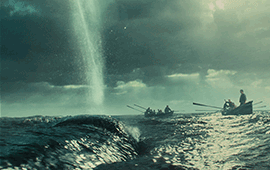Just as Charles Dickens altered our perceptions of Christmas with his landmark story A Christmas Carol, so too did director Frank Capra create a festive masterpiece for the ages in the form of It’s a Wonderful Life. Here are 5 reasons why we elect it as the greatest Christmas movie ever made.
1) James Stewart's incredible performance
The movie is frequently dismissed as sugary hogwash (indeed the film’s antagonist Mr Potter, played by Lionel Barrymore, would likely describe it as such). But the magic of the film is in the way it extracts a timeless moral from a story about a decent man contemplating suicide.
As portrayed by James Stewart, arguably the Golden Age’s finest purveyor of human decency, George Bailey becomes the most vital, believable and sympathetic protagonist ever seen in a motion picture. We trace his wonderful life from the start, when he saves his brother from drowning in a frozen lake, to his marriage to childhood sweetheart Mary (Donna Reed) to his eventual financial struggles.
Along the way, he is forced to give up his dreams of travelling and is locked in an eternal struggle with the aforementioned, odious Dickensian villain Mr Potter. But it is only when George, on the verge of suicide, is visited by his guardian angel Clarence Odbody (Henry Travers) that he realises what a plethora of humane riches he has bestowed on those around him.
2) It's darker than you remember
Clarence shows George the bleak horror of alternate life in which he never existed. George finds his town of Bedford Falls has been transformed into Pottersville; his brother Harry was unable to save the lives of comrades on a transport in WWII (because George wasn’t there to save Harry as a child); his wife is a spinster; and his mother doesn’t recognise him.
It’s subsequently a much darker film than is commonly suggested, making George’s final push for redemption one of the most magical, gut-wrenching journeys seen on the big-screen. After all, it is about a man contemplating suicide and the circumstances that have brought him to such a position.
3) The story is incredibly relatable
Stewart, bringing his traumatic World War II experience to bear on the role, makes the simple struggle to remain a good man the most gripping story of all. Throughout, we will George to fight against the darkness and bitterness within him, desperately wanting to cry out that he needn’t yield to life’s cruelty. Miraculously, it’s never corny; just a celebration of love, courage and genuine emotion.
4) It changed cinema forever
The movie also revolutionised Christmas movies in other ways. Ever paid close attention to the on-screen depiction of snow before? Of course not, because it's usually pretty realistic. And we've got It's a Wonderful Life to thank for that. Capra utilised a new, more sophisticated form of chemical snow in order to avoid the on-set noise created by the crushed-up cornflakes that had been used previously.
The town setting of Bedford Falls adds a great deal to the movie's realism and little wonder: shot on the RKO studio lot in California and stretching for three city blocks, Capra's attention to detail helps draw audiences further into the movie's wondrous storyline. Add to this the movie was shot during the middle of a heatwave and its emergence as an all-time festive classic is all the more impressive.
5) It's a genuine underdog movie
It might be regarded as a classic now, but It's a Wonderful Life only gained a reputation over the decades. Initially released to disappointing box office and middling reviews in 1946, the film displayed some of George Bailey's own plucky spirit by emerging as a masterpiece of world cinema during regular TV broadcasts in the 1970s.
Nevertheless, it was always a favourite of director Capra and stars Stewart and Reed. "The film has a life of its own now," Capra said years after release, "and I can look at it like I had nothing to do with it. I'm like a parent whose kid grows up to be president. I'm proud... but it's the kid who did the work."
6) It's got the greatest ending in cinema history
As Auld Lang Syne reverberates on the heart-strings during the climax, and George comes to realise the magnitude of his apparently insignificant life, it’s impossible not to be moved.
It’s not just the potent, heartwrenching emotion that we register on Stewart's face; it’s the well-spring of humanity that has come bubbling up to wash over the audience. Never again would cinema work such wonders. Were that we to get a film this good every time a bell rings.
Do you love It's a Wonderful Life? If so, tweet your reasons @Cineworld. And happy Christmas!


